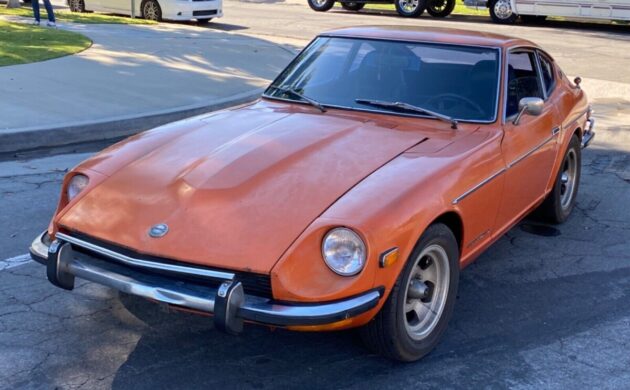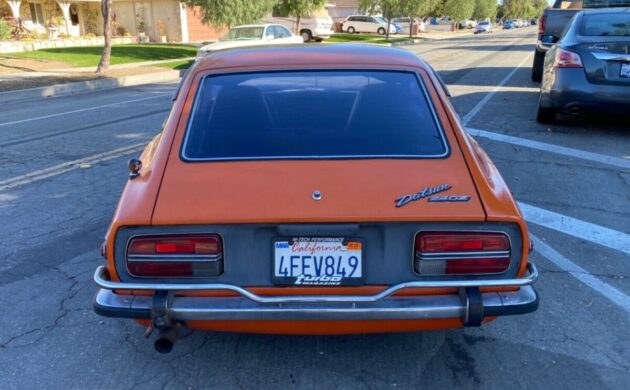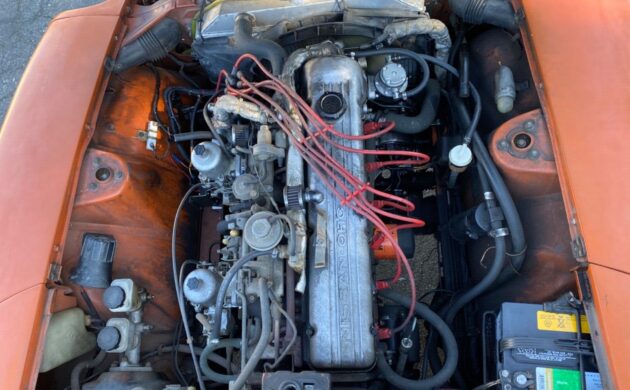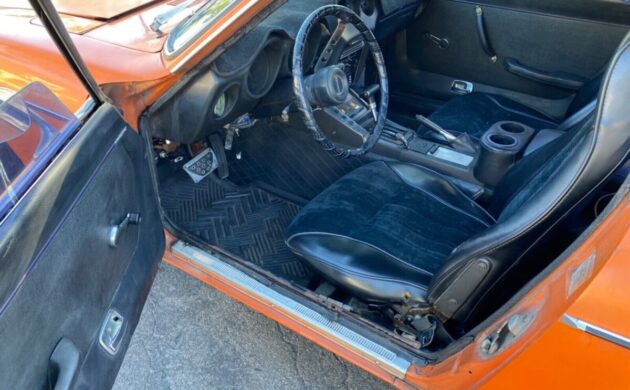Seeing the success that imported British sports cars were having in markets like the U.S., Nissan stepped up its game by introducing the Z series of 2-seat coupes. They would be an extension of the open-top roadsters from the 1960s that were known as Fairlady Zs on the home front. The Datsun 240Z was produced from 1970 to 73, replaced in order by the 260Z and 280Z with bigger engines. This ’73 240 looks like a solid auto but needs some tinkering under the hood to perform as it should. Located in Anaheim, California, this Japanese sports car is available here on eBay for $19,500 (or you can make an offer).
Before the mid-1980s, Nissan-built cars were sold in the U.S. under the Datsun brand before switching to the corporate name. The 240Z got its identity from this displacement of its engine, a 2,393-cc (146 cubic inches) overhead cam inline-six with a cast-iron block, alloy head, two valves per cylinder, and a seven-bearing crankshaft. They became quite popular and proved that an imported sports car didn’t have to be quirky or require constant maintenance as some of the English sports cars did. In short order, the Z became Nissan’s biggest seller in the U.S. at a time when several Japanese manufacturers were trying to get a foothold in the lucrative market.
With its bright orange paint, an original color, it would be hard to lose this ’73 240Z in a parking lot. We don’t know if the little car has been repainted at some point, but there’s probably no reason to worry about the body or paint at this stage. We’re told it’s spent its entire life in California, a plus for sheet metal conservation. It has two options that weren’t commonplace in the cars: an automatic transmission (most buyers went with the 4-speed manual) and factory air conditioning. No mention is made as to how well the latter works.
At 96,000 miles, we gather the Z has been sitting for a time as the seller says it will need servicing and new tires. The drivetrain is numbers matching, so it may be getting a bit tired at this stage. While you’re under the hood, the carburetors will need some adjustment to operate properly, and the “belt” will need some attention. It runs and drives but we gather not particularly well at this time. A video clip has been provided by the seller and he/she offers more photos if you need them. Unless you go to a show that focuses on Japanese cars, you don’t see many of these on the road anymore.






The automatic reduces the desirability for me, and probably many others who would consider picking up this car.
The BIN price is now $15,700
The biggest headache with these cars was rust, I believe. It could hide and cause even structural problems with the unibody. Hope it finds a good home!
Cup holders ? Back then or an add on?
That’s an add-on. No cup holders from the factory. Looks like it’s a whole console apparatus.
I put 32k IN one year on my 1972 Z car commuting back and forth from KCMO and KU University. And a few trips to Colorado Springs. It never let me down once!!! Great car and fun to drive!!!
As I recall from when these first hit the road (and just about everybody I knew wanted one), most of them seemed to be this color. I’d be curious to know the figures on which colors sold best.
I bought a 1971 240Z 4 speed manual with 100K miles in the mid ‘70’s. I put another 100K on it before everything wore out. Sold it for $1500.
To convert this to a more desirable 4 speed is very straight forward as all the stampings on the shell are there for both boxes, all you need is the parts and simply bolt them in with no mods……..
I probably am repeating myself, but if $10k were the price, I would install the 2.8 fuel injected with a five speed and power steering. In my scenario. the 1978 with that equipment would be my last driver.
I always thought those baby chrome tube bumpers above the regular bumpers were both strange & useless. Can i assume they are aftermkt? I seen them on a few old Z cars, but oddly on no others.
Yes it was a dealer installed option. In most cases to drive up profit.
As was the A/C. Factory AC was not an option on the 240Z. The 260Z was the first model it was available.